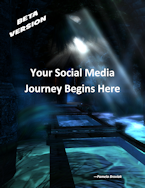While I still enjoy books and love going to the library, I have come to favor using the Internet when researching a specific subject. Not only is it easy to find and collect and organize information, but the social media side of it allows me to also get the pulse of the public on that topic. And by using specific tools available online for curating information, it's easy to pull it all together for easy access and reference. I haven't really heard of any firms or agencies using this approach to develop feasibility studies, although I would think some out there are following this process. So I thought I'd lay out below the steps that could be taken to set this up for a specific study in case someone was not doing this and wanted to try it out. Because lately I've been focused on bike planning, design, and management, I will use that topic in my examples:
Collect Your Information
Set up a Twitter Feed
One of the first steps I take to collect information on a specific topic is to set up a Twitter Feed. You can see I added one on bikes to the right sidebar of this blog. Even though not every Tweet out there in the Twitterverse will be what I want, the format allows me to easily scan for what I do need. If you don't initially have a place to embed a widget like you see in the sidebar on this page, you can just visit the Twitter site and type #bikes in the search window at the top of the page. Here is the link to a search for the #bikes hashtag on Twitter.
Google Drive
Once you start getting information, you'll want a place to store links and ideas you have found. There are several tools out there to help you with this task. You might want to try a couple at first as a test until you settle on which one works best for you. One of the easiest is to just set up a Google document on Google Drive. Anyone with a Google account can access Google Drive by signing into their account and clicking the word "Drive" at the top of the screen. Once there, you can click the "create" button and choose what type of document you would like to use to store your information. I chose a "Document" which on Google is like a word processing page. The benefit of using Google Drive is it also lets you embed your documents on other sites. And you can share your document with others so everyone can work on it together. Here is what I have so far in my document about bicycle resources:
Shelfari
Shelfari is a site where you can collect books related to your topic into a digital bookshelf. Here is one I set up with a few books related to bicyle infrastructure:
Livebinders
Livebinders is another popular site for collecting and organizing links related to a specific topic. I created one to collect links to sites with information about bicycle infrastructure. You can access it by clicking the icon below:
MindMaps
Mind Maps are useful to display related information in a visual manner. There are several different Mind Map tools out there. For this example I used the free version of Bubbl.us. The beginning of a Bicycle Infrastructure MindMap is below:
Display Your Collections on a Website
You can also use a free website creation tool to set up your own site for collecting and displaying information about your topic. The benefit of actually setting up a site rather than just collecting links in a document or specific tool is that you can embed all tools used in one place. One example of a free website creation tool is Wix. I did not set up a site as an example because this blog serves this purpose for me. This option is best if you could not display everything you found in one of the tools above and you wanted to use different tools for different types of links and resources.
Analyze and discuss your information
Once you have collected and organized your research you can begin analyzing it and discussing it with others. If you are working as part of a team, having everything linked allows for easy access and sharing between members of the group. Social media tools can also support this part of the process.
The articles and comments on blogs are particularly useful for analyzing public opinion, experiences, and feedback. For example, if you follow the link to the article on the Seattle Bike Blog, you'll find a wealth of feedback related to protected bike lanes. In the original article, there is information shared from a traffic engineer. Then in the comments, bikers share their knowledge, experience, and information about the use of a specific type of protection for bike lanes. It would be difficult to get this amount of feedback at this level from any other source. Someone studying this type of bike lane protection could document the number of people commenting who had accidents because of this specific element. Ideas for improving on the design of this type of practice can also be found on the site.



